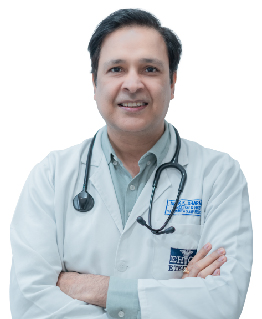Chronic obstructive pulmonary diseases or COPD can cause airflow limitation, hyperinflation and reduced gas exchange that lead to progressive dyspnea. While pulmonary rehabilitation, pharmacotherapy, oxygen therapy are the basic management strategies to address these ailments, some of them may also require a more direct approach to ensure improved results. Interventional bronchoscopy is a minimally invasive therapeutic procedure that addresses all types of lung neoplasm. With the advent of new technology, this field has progressed amazingly over the last few decades. However, it is only available at a selected few speciality hospitals.
At Eternal Hospital, we offer flexible fiberoptic bronchoscopy for airway inspection to identify airway lesions, therapeutic aspiration of airway secretions and transbronchial biopsy to diagnose parenchymal lung disorders.
Why is it performed?
Bronchoscopy is usually performed to find an underlying problem in the lungs or airway. However, a doctor may also recommend bronchoscopy to find the cause of a persistent cough or an abnormal chest X-ray. While it's usually performed to get an accurate diagnosis, doctors may also recommend it to cure the condition.
People with lung cancers also have a narrow trachea that may cause respiratory problems or an obstructed bronchial tree. Interventional bronchoscopy can relieve airway obstruction by cutting the tumour.
Common reasons for bronchoscopy include:
- Diagnosis of a lung problem
- A lung infection
- Biopsy of tissue from lungs
- Removal of mucus from the airways
- Placement of a small stent to hold open an airway
- Treating a collapsed lung
How is Interventional Bronchoscopy done?
Bronchoscopy is usually performed by a doctor who specializes in lung disorders. During bronchoscopy, a thin tube is inserted through the patient's nose or mouth into their lungs. This instrument has a tiny camera that displays the picture on a monitor while the doctor performs the procedure. As the process advances, the doctor will position the bronchoscope slightly towards the back of the throat and push it down through the vocal cords into the airways.
They will take the fluids or the tissues obstructing the airways using the devices that pass through the bronchoscope. The process is a bit uncomfortable and is usually performed under anaesthetic medicines.
What happens after the procedure?
After the procedure, the patient will be monitored for several hours. Until the numbness goes away, they won't be allowed to eat or drink anything.
While sore throat, cough, and muscle ache are common after the procedure, warm water gargles are enough to lessen the discomfort.
Why Eternal Hospital?
At Eternal Hospital, we have a highly qualified and dedicated team of urologists who are always committed to providing the latest and most advanced medical care to all our patients. Being a trusted name in healthcare, we act compassionately while ensuring confidentiality to those who need it. We have set high standards in patient-centric premium care and outstanding patient safety, and exceptional maintenance in a timely manner. We adhere to the use of up to the minute innovations to offer state-of-the-art treatments to our patients with unparalleled results.


